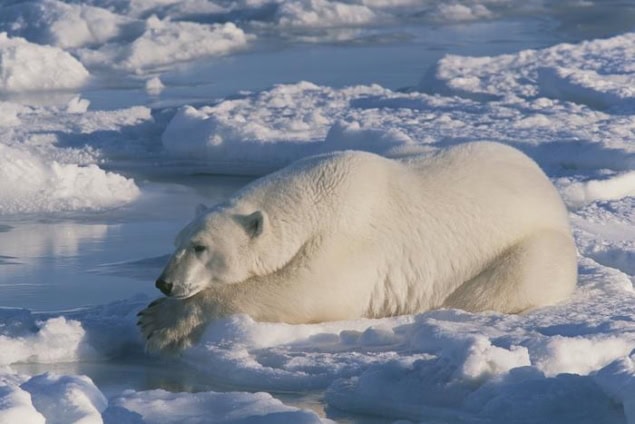
In the teeth of the Arctic winter, polar-bear fur always remains free of ice – but how? Researchers in Ireland and Norway say they now have the answer, and it could have applications far beyond wildlife biology. Having traced the fur’s ice-shedding properties to a substance produced by glands near the root of each hair, the researchers suggest that chemicals found in this substance could form the basis of environmentally-friendly new anti-icing surfaces and lubricants.
The substance in the bear’s fur is called sebum, and team member Julian Carolan, a PhD candidate at Trinity College Dublin and the AMBER Research Ireland Centre, explains that it contains three major components: cholesterol, diacylglycerols and anteisomethyl-branched fatty acids. These chemicals have a similar ice adsorption profile to that of perfluoroalkyl (PFAS) polymers, which are commonly employed in anti-icing applications.
“While PFAS are very effective, they can be damaging to the environment and have been dubbed ‘forever chemicals’,” explains Carolan, the lead author of a Science Advances paper on the findings. “Our results suggest that we could replace these fluorinated substances with these sebum components.”
With and without sebum
Carolan and colleagues obtained these results by comparing polar bear hairs naturally coated with sebum to hairs where the sebum had been removed using a surfactant found in washing-up liquid. Their experiment involved forming a 2 x 2 x 2 cm block of ice on the samples and placing them in a cold chamber. Once the ice was in place, the team used a force gauge on a track to push it off. By measuring the maximum force needed to remove the ice and dividing this by the area of the sample, they obtained ice adhesion strengths for the washed and unwashed fur.
This experiment showed that the ice adhesion of unwashed polar bear fur is exceptionally low. While the often-accepted threshold for “icephobicity” is around 100 kPa, the unwashed fur measured as little as 50 kPa. In contrast, the ice adhesion of washed (sebum-free) fur is much higher, coming in at least 100 kPa greater than the unwashed fur.
What is responsible for the low ice adhesion?
Guided by this evidence of sebum’s role in keeping the bears ice-free, the researchers’ next task was to determine its exact composition. They did this using a combination of techniques, including gas chromatography, mass spectrometry, liquid chromatography-mass spectrometry and nuclear magnetic resonance spectroscopy. They then used density functional theory methods to calculate the adsorption energy of the major components of the sebum. “In this way, we were able to identify which elements were responsible for the low ice adhesion we had identified,” Carolan tells Physics World.
This is not the first time that researchers have investigated animals’ anti-icing properties. A team led by Anne-Marie Kietzig at Canada’s McGill University, for example, previously found that penguin feathers also boast an impressively low ice adhesion. Team leader Bodil Holst says that she was inspired to study polar bear fur by a nature documentary that depicted the bears entering and leaving water to hunt, rolling around in the snow and sliding down hills – all while remaining ice-free. She and her colleagues collaborated with Jon Aars and Magnus Andersen of the Norwegian Polar Institute, which carries out a yearly polar bear monitoring campaign in Svalbard, Norway, to collect their samples.
Insights into human technology
As well as solving an ecological mystery and, perhaps, inspiring more sustainable new anti-icing lubricants, Carolan says the team’s work is also yielding insights into technologies developed by humans living in the Arctic. “Inuit people have long used polar bear fur for hunting stools (nikorfautaq) and sandals (tuterissat),” he explains. “It is notable that traditional preparation methods protect the sebum on the fur by not washing the hair-covered side of the skin. This maintains its low ice adhesion property while allowing for quiet movement on the ice – essential for still hunting.”

Polar bear fur inspires solar-thermal textiles
The researchers now plan to explore whether it is possible to apply the sebum components they identified to surfaces as lubricants. Another potential extension, they say, would be to pursue questions about the ice-free properties of other Arctic mammals such as reindeer, the arctic fox and wolverine. “It would be interesting to discover if these animals share similar anti-icing properties,” Carolan says. “For example, wolverine fur is used in parka ruffs by Canadian Inuit as frost formed on it can easily be brushed off.”



